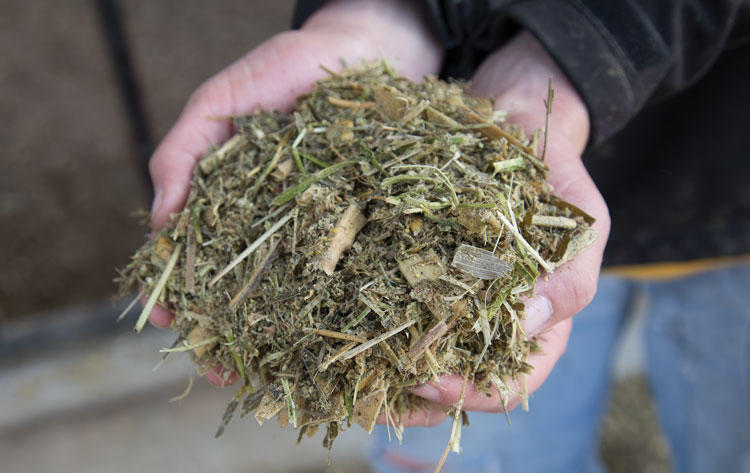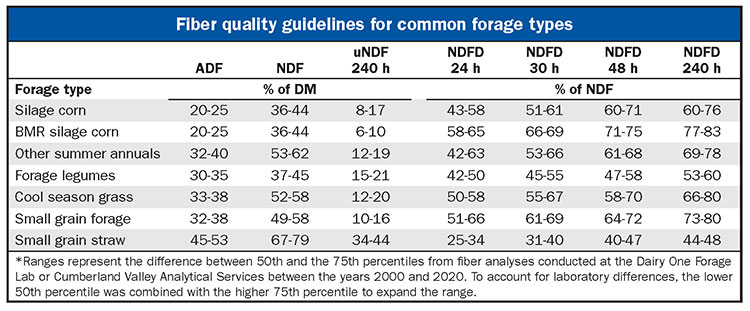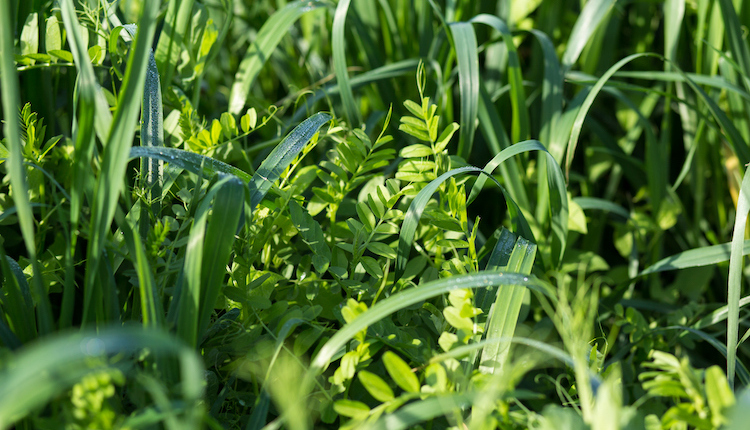
The fresh cow requires neutral detergent fiber (NDF) from high-quality forages such as brown midrib (BMR) corn silage, alfalfa, and even nonforage sources of fiber. The fiber component of high-quality forages has rapid rumen degradability and provides ample energy to the cow as the animal begins its lactation.
Fresh cow forage must also create a well-formed rumen digesta mat. Chopped grass or even straw helps to provide the right balance between NDF degradability (NDFD) and particle size to optimize feed intake and rumen health.
Forage fiber degrades, leaves the rumen slowly, and largely determines the “filling” effect of the ration. This rumen-filling effect varies considerably among forages due to differences in degradability of the NDF. Desirable forages for fresh cows have fiber that degrades quickly and has a lower fill effect that promotes feed intake and milk production. Rapidly ascending intake characterizes the healthy fresh cow, and forages with high NDFD form the base of ideal fresh cow rations.
Forage sources for fresh cows
Corn and alfalfa are typically the heavy hitters when it comes to feeding fresh cows — and for good reason. Few species can compete with the yield of digestible dry matter produced by these two forages on prime agricultural soils.
If alfalfa or corn silage supplies are limited for some reason, other forage types can certainly fit the bill. The challenge is to find a crop (or cropping system) that yields favorably but still meets the needs of high-producing dairy cows.
Some common alternative forages include summer annuals such as millets, sorghum, and sorghum-sudangrass, along with various cereal crops like oats or triticale. For summer annual grasses, select brown midrib varieties to avoid NDF that is too poorly degraded and will likely limit dry matter intake.
On highly productive soils, the role of alternative forages may be to augment a corn or alfalfa crop rather than to replace it entirely. Examples of this include harvesting cover crop mixes prior to corn or planting a companion crop with alfalfa. If soils are not suited for corn or alfalfa production, alternative forages may need to take on a more prominent role. In soils that are somewhat poorly drained, a less common species such as birdsfoot trefoil may outyield alfalfa while maintaining forage quality. Just keep in mind that every forage type comes with a unique set of management challenges (like poor establishment with birdsfoot trefoil).
When selecting an alternative forage crop, it’s important to remember that fiber characteristics may vary substantially among forage varieties and species. Look at local forage trial results before deciding what to plant whenever possible.
One difficulty is that many forage trials do not report enough information on the fiber degradability of the entries. Evaluating fiber degradability at different time points is a key step in understanding the nutritional value of forage fiber so that it can be best utilized for fresh, dry, peak, or mid-lactation animals.
Fiber degradability is often assessed at the 24-, 30- and 48-hour time points, and these are highly useful quality benchmarks. But looking at earlier time points can better assess legumes and other rapidly degrading fiber sources.
In fact, some commercial laboratories are just starting to offer 12-hour in vitro time points that provide a more accurate measure of fiber degradation rate for forages such as alfalfa. Some nutritionists have started to use the 12-hour degradability analysis when evaluating forages, but this information is scarcely available in agronomic comparisons.
On the other end of the spectrum, the undegradable NDF at 240 hours of fermentation (uNDF240) is used as a measure of the fiber that doesn’t degrade in the rumen, and it can be subtracted from NDF to measure potentially degradable NDF. The uNDF240 is being reported more often and used by nutritionists as an indicator of gut fill limitations and dry matter intake potential of a forage. A high uNDF240 content and slower rate of rumen NDF degradation may be the primary limitations for many alternative forages in dairy rations.
Is there anything you can do if uNDF240 is too high in your forage?
Recent research at the Miner Institute suggests that reducing the particle size of the forage may allow for greater feed intake and milk yield when compared to coarsely chopped, high uNDF240 forages. When focusing on the fresh cow, we want to promote intake, but we must also be cautious of too finely chopping forages. A minimum quantity of physically effective NDF is required for good chewing activity and rumen health, typically about 20% to 23% of ration dry matter.
Fiber guidelines for fresh cows
The table reports the acid detergent fiber (ADF) and NDF content of various forage types suitable for fresh cows as well as their in vitro NDFD at the 24-, 30-, 48-, and 240-hour time points. The table was created using commercial forage laboratory data. Insufficient data were available to include a 12-hour degradability time point for rapidly fermenting forages.

The ranges reported are not meant to represent the full range of forage quality possible for each forage type. Rather, the ranges were developed using the 50th and 75th percentiles to approximate attainable goals for fiber quality that might be achieved with reasonable management techniques. While some farms may occasionally attain forage quality in excess of the 75th percentile, maintaining a multi-year average at this level may be extremely challenging. It would require harvesting at earlier maturities than usual and may result in reductions in total seasonal yields under some conditions.
Put into practice
When inventories of traditional forages are limited and alternative forages need to be fed, the key will be to formulate diets that still allow target dry matter intake amounts to be achieved in the first few weeks of lactation. Maintaining normal chewing behavior, rumen fill, and intake are critical for fresh cow success. Using the fiber content and degradability benchmarks provided in the table will allow you to successfully feed a wide range of forages.










